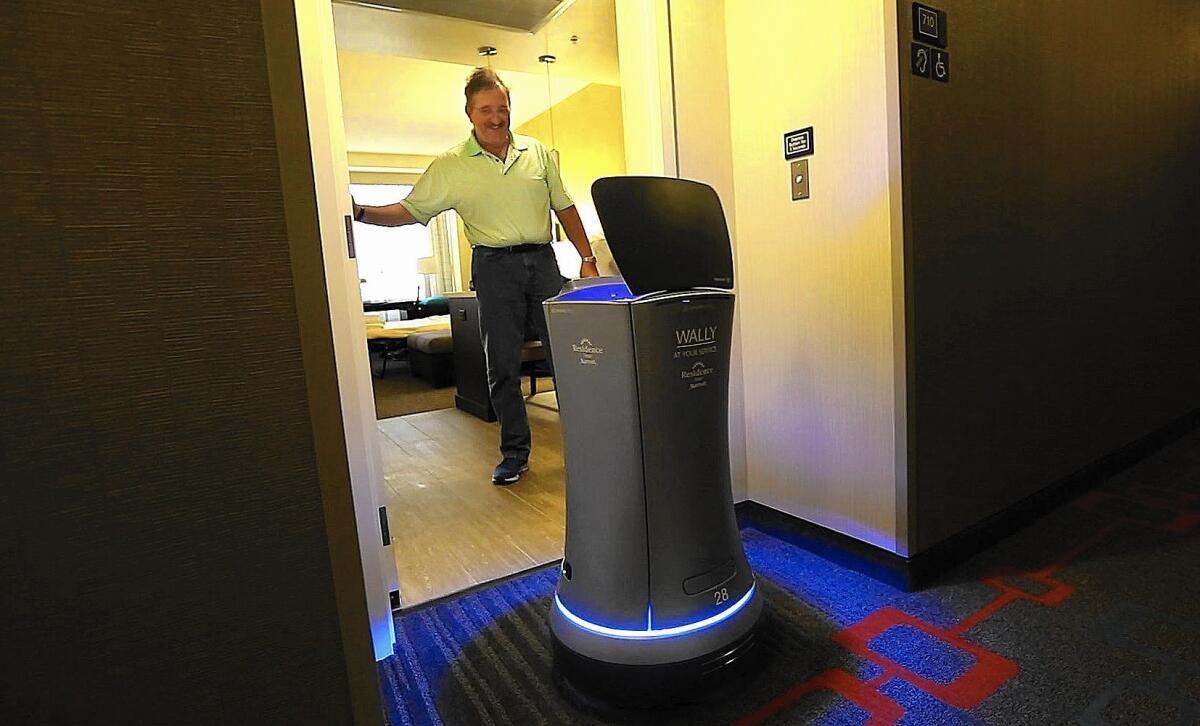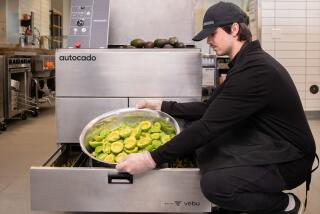Cutting Edge: Robots deliver fun with hotel room service orders, and they don’t expect a tip

Your hotel’s newest bellhop may be a robot.
A Santa Clara, Calif., start-up and its “autonomous robot helpers” received $15 million in new financing last month. Savioke’s goal is to put robots in hotels across the country, building on its current stable of 12, including one near Los Angeles International Airport.
“We have lots of robots that are ready to go,” Savioke co-founder Tessa Lau said.
The 100-pound, 3-foot-tall Savioke robot, dubbed Relay, is built primarily to deliver extra towels, toothpaste or other necessities to guest rooms. The hotel staff punches in a room number on the robot’s touch screen and Relay rolls into the elevator and up to the designated room.
The robot doesn’t have arms and can communicate with guests only through typed messages that appear on its display screen. It uses Wi-Fi and 3-D cameras to navigate around the hotel.
The machines are probably the most “Jetsons”-like facet of the hospitality industry’s efforts to up its automation game.
Most new hotels have installed temperature control systems that shut off the heating and cooling when guest rooms are empty. A few hotels put computer tablets in the rooms that guests can use to order room service, request a taxi or close the blinds.
Major hotel operators such as Marriott International have created smartphone apps to let guests check in using their mobile devices. Hilton Worldwide now lets guests use their smartphones to open their hotel room doors in 112 hotels and plans to add the technology to its newest brand, Tru, which launches later this year.
Near Nagasaki, Japan, a hotel linked to a nearby amusement park is staffed entirely by robots. The guest room doors open using face-recognition software.
Still, hospitality industry experts disagree on how much automation U.S. hotel owners will accept, especially at high-end locations where guests expect staff to serve them with tailored attention and practiced obsequiousness.
“With robots, you don’t get personalized service,” said Steve Choe, general manager of the InterContinental Los Angeles Century City, a luxury hotel with 361 rooms, including 151 suites. “Those are the touches people still want.”
That may be true of most high-end hotels, said Lynn Mohrfeld, president of the California Hotel and Lodging Assn. But he suggested that robots would be popular at hotels that cater to millennials with a fascination for high-tech gadgets.
“In a four-star hotel in Silicon Valley, this would be a nice novelty,” he said.
Although Relay is primarily a novelty designed to attract tech-happy guests, hotel owners and managers say they are pursuing other automation technology to cut down on the industry’s two biggest expenses: staffing and energy costs.
Phone apps and kiosks that let guests check in faster free up front desk staff to attend to other guest needs, while technology that shuts down air-conditioning units when rooms are empty can save on expensive energy costs.
“Automating the heating and air conditioning makes sense, especially in places with wild swings in temperatures,” Mohrfeld said.
Savioke received its latest infusion of capital from Intel Capital, EDBI, the corporate investment arm of the Singapore Economic Development Board and Northern Light Venture Capital. The seed money for the company came from Google Ventures, the investment arm of the search engine giant, and a venture capital group led by former Yahoo executives, among others.
Hotels that order the robot pay Savioke a monthly fee that includes maintenance. The company declined to disclose the leasing fee.
At the Residence Inn by Marriott on Century Boulevard, the robot has been rolling the halls for a few months and was recently upgraded to deliver orders for Starbucks coffee.
Although the robot’s factory name is Relay, each hotel has given its machine a unique moniker. At the Residence Inn, they call it Wally. Other hotels have dubbed it Dash and Botlr.
Other California inns that employ Relay include the Crowne Plaza San Jose-Silicon Valley in Milpitas, the Grand Hotel in Sunnyvale, the Aloft Silicon Valley in Newark, the Aloft Cupertino in Cupertino and the Holiday Inn Express in Redwood City.
The robot, shaped like a giant flower vase, contains an enclosed compartment where hotel staff can put drinks, snacks or other items that guests order from the front desk. Toothpaste makes the trip most often.
When the machine isn’t in use, it can navigate back to the front desk to recharge its batteries.
Residence Inn General Manager Tom Beedon said the robot has been a big hit with guests, particularly young visitors who order things from the front desk just so they can post pictures of Wally on social media. (In lieu of tips, the robot asks for mentions on Twitter.)
“The feedback on social media has been over the top,” Beedon said.
On the Yelp review site, a guest who visited in October from Austin said: “Oh, my goodness, I just have to start by gushing over Wally; I am completely enamored with that little guy!”
The robot isn’t expected to take jobs away from human employees, Beedon said. Instead, it is more likely to free up front desk staff to do more complicated hotel chores, he said.
There are drawbacks to a delivery robot. After Wally brought fresh towels to a room a few weeks ago, the guest dumped his used, wet towels into the robot’s compartment. Wally promptly short-circuited.
“That was a sad day,” Beedon said. “It was like having an injured employee.”
After the robot was repaired, the general manager made a suggestion to Savioke: “They have to find a way to make that thing waterproof.”
Savioke is working on a fix, Lau said.
“The idea that someone would put wet towels in it never crossed our minds,” she said.
Twitter: @hugomartin
ALSO
6th Street Bridge finally starts to fall to demolition crews
After San Bernardino terror attack, many are attending active shooter trainings
Local efforts to raise minimum wage could take a back seat as cities wait for state to act
More to Read
Inside the business of entertainment
The Wide Shot brings you news, analysis and insights on everything from streaming wars to production — and what it all means for the future.
You may occasionally receive promotional content from the Los Angeles Times.











